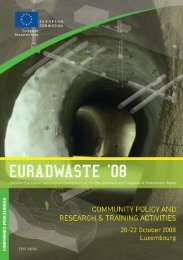EU industrial structure - EU Bookshop - Europa
EU industrial structure - EU Bookshop - Europa
EU industrial structure - EU Bookshop - Europa
You also want an ePaper? Increase the reach of your titles
YUMPU automatically turns print PDFs into web optimized ePapers that Google loves.
<strong>EU</strong> <strong>industrial</strong> <strong>structure</strong> 2011 — Trends and Performance<br />
economy. While the average annual growth in persons<br />
employed in the <strong>EU</strong> in 1995‑2009 was 2 %, it decreased on<br />
average by 1 % in manufacturing industries. Manufacturing<br />
employment only grew in transport equipment, rubber and<br />
plastics and other manufacturing. Strongest employment<br />
FIgURE III.14: Average annual growth of persons employed in the <strong>EU</strong> 1995-2009 (%)<br />
Real estate and business activities<br />
Agriculture, hunting and forestry<br />
70<br />
Hotels and restaurants<br />
Other services<br />
TOTAL<br />
Health and social work<br />
Construction<br />
Wholesale and retail trade<br />
Education<br />
Transport and communication<br />
Financial intermediation<br />
Public administration<br />
Rubber and plastics<br />
Transport equipment<br />
Other manufacturing<br />
Other mining<br />
Food, drinks and tobacco<br />
Basic metals and metal products<br />
Electrical and optical equipment<br />
Electricity, gas and water supply<br />
Machines n.e.c.<br />
Manufacturing<br />
Chemicals<br />
Non-metallic mineral products<br />
Pulp, paper and publishing<br />
Wood and wood products<br />
Fishing<br />
Mining and quarrying<br />
Rened petroleum<br />
Mining of energy products<br />
Leather and footwear<br />
Textiles and clothing<br />
Source: own calculations using Eurostat data.<br />
-5 -4 -3 -2 -1 0 1 2 3 4 5<br />
A more detailed and updated picture of the evolution<br />
of labour input in manufacturing can be provided by<br />
studying sectors at the 2‑digit level. 46 Hours worked is<br />
closely correlated with the number of persons employed.<br />
In the 2009 edition of <strong>EU</strong> Industrial Structure, the data ended<br />
46 Due to the change from NACE Rev. 1 to NACE Rev. 2, Table III.5 and<br />
Table III.6 are not completely comparable with each others.<br />
growth in service industries was seen in real estate and<br />
business activities, hotels and restaurants and other services.<br />
In these sectors employment on average grew more than in<br />
the total <strong>EU</strong> economy, cf. Figure III.14.<br />
in September 2008 and the slump had not yet materialised<br />
in all manufacturing sectors. This illustrates a lag in how the<br />
crisis has affected the <strong>EU</strong> labour market. While production<br />
was hurt first, labour hoarding prevented a strong fall in<br />
employment. In a second stage, the fall in demand has hit<br />
employment in sectors. The most impacted manufacturing<br />
industries (until the last quarter of 2010) were clothing,<br />
textiles, leather and tobacco, cf. Table III.3.
















